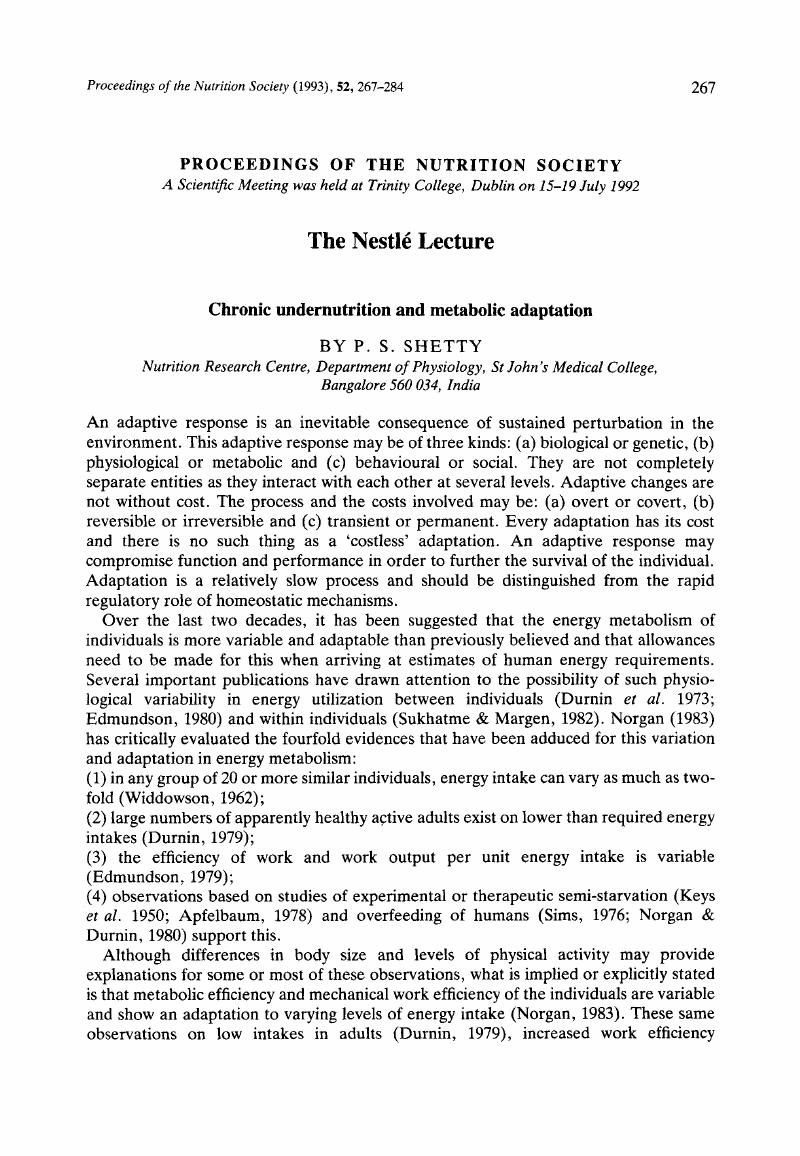Crossref Citations
This article has been cited by the following publications. This list is generated based on data provided by Crossref.
Summerbell, Carolyn
1994.
Appetite and nutrition in relation to human immunodeficiency virus (HIV) infection and acquired immunodeficiency virus syndrome (AIDS).
Proceedings of the Nutrition Society,
Vol. 53,
Issue. 1,
p.
139.
Phillips, D.I.W.
1995.
Relation of Fetal Growth to Adult Muscle Mass and Glucose Tolerance.
Diabetic Medicine,
Vol. 12,
Issue. 8,
p.
686.
MacDonald, I. A.
and
Webber, J.
1995.
Feeding, fasting and starvation: factors affecting fuel utilization.
Proceedings of the Nutrition Society,
Vol. 54,
Issue. 1,
p.
267.
Bhutta, Zulfiqar Ahmed
and
Hendricks, Kristy M.
1996.
Nutritional Management of Persistent Diarrhea in Childhood: A Perspective from the Developing World.
Journal of Pediatric Gastroenterology & Nutrition,
Vol. 22,
Issue. 1,
p.
17.
Bhutta, Zulfiqar Ahmed
and
Hendricks, Kristy M.
1996.
Nutritional Management of Persistent Diarrhea in Childhood: A Perspective from the Developing World.
Journal of Pediatric Gastroenterology and Nutrition,
Vol. 22,
Issue. 1,
p.
17.
Ferro-Luzzi, Anna
and
James, W.P.T.
1996.
Adult malnutrition: simple assessment techniques for use in emergencies.
British Journal of Nutrition,
Vol. 75,
Issue. 1,
p.
3.
Ulijaszek, Stanley J.
1996.
Energetics, adaptation, and adaptability.
American Journal of Human Biology,
Vol. 8,
Issue. 2,
p.
169.
Ferro-Luzzi, A
Petracchi, C
Kuriyan, R
and
Kurpad, AV
1997.
Basal metabolism of weight-stable chronically undernourished men and women: lack of metabolic adaptation and ethnic differences.
The American Journal of Clinical Nutrition,
Vol. 66,
Issue. 5,
p.
1086.
Capristo, E.
Mingrone, G.
Addolorato, G.
Greco, A. V.
Corazza, G. R.
and
Gasbarrini, G.
1997.
Differences in Metabolic Variables between Adult Coeliac Patients at Diagnosis and Patients on a Gluten-Free Diet.
Scandinavian Journal of Gastroenterology,
Vol. 32,
Issue. 12,
p.
1222.
Berti, Peter R.
Leonard, William R.
and
Berti, Wilma J.
1998.
Stunting in an Andean community: Prevalence and etiology.
American Journal of Human Biology,
Vol. 10,
Issue. 2,
p.
229.
Stubbs, R. James
1998.
Appetite, feeding behaviour and energy balance in human subjects.
Proceedings of the Nutrition Society,
Vol. 57,
Issue. 3,
p.
341.
Soares, Mario J.
Piers, Leonard S.
O'Dea, Kerin
and
Shetty, Prakash S.
1998.
No evidence for an ethnic influence on basal metabolism: an examination of data from India and Australia.
British Journal of Nutrition,
Vol. 79,
Issue. 4,
p.
333.
Barera, Graziano
Mora, Stefano
Brambilla, Paolo
Ricotti, Alberto
Menni, Laura
Beccio, Sabrina
and
Bianchi, Cesare
2000.
Body composition in children with celiac disease and the effects of a gluten-free diet: a prospective case-control study.
The American Journal of Clinical Nutrition,
Vol. 72,
Issue. 1,
p.
71.
Norgan, N. G.
2000.
Long-term physiological and economic consequences of growth retardation in children and adolescents.
Proceedings of the Nutrition Society,
Vol. 59,
Issue. 2,
p.
245.
Prentice, Andrew M
2001.
Obesity and its potential mechanistic basis.
British Medical Bulletin,
Vol. 60,
Issue. 1,
p.
51.
Ulijaszek, Stanley J.
2002.
Human eating behaviour in an evolutionary ecological context.
Proceedings of the Nutrition Society,
Vol. 61,
Issue. 4,
p.
517.
Shetty, P.S.
and
Waterlow, J.C.
2003.
Encyclopedia of Food Sciences and Nutrition.
p.
18.
Lieberman, Leslie Sue
2003.
DIETARY, EVOLUTIONARY, ANDMODERNIZINGINFLUENCES ON THEPREVALENCE OFTYPE2 DIABETES.
Annual Review of Nutrition,
Vol. 23,
Issue. 1,
p.
345.
Briet, Francoise
Twomey, Clare
and
Jeejeebhoy, Khursheed N
2004.
Effect of feeding malnourished patients for 1 mo on mitochondrial complex I activity and nutritional assessment measurements.
The American Journal of Clinical Nutrition,
Vol. 79,
Issue. 5,
p.
787.
Ferro-Luzzi, Anna
2005.
The conceptual framework for estimating food energy requirement.
Public Health Nutrition,
Vol. 8,
Issue. 7a,
p.
940.



